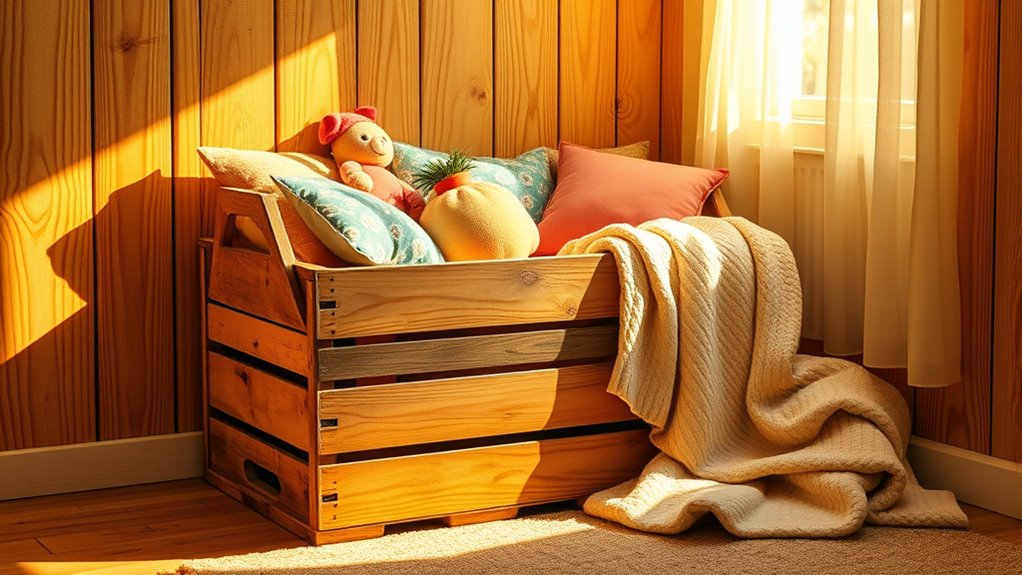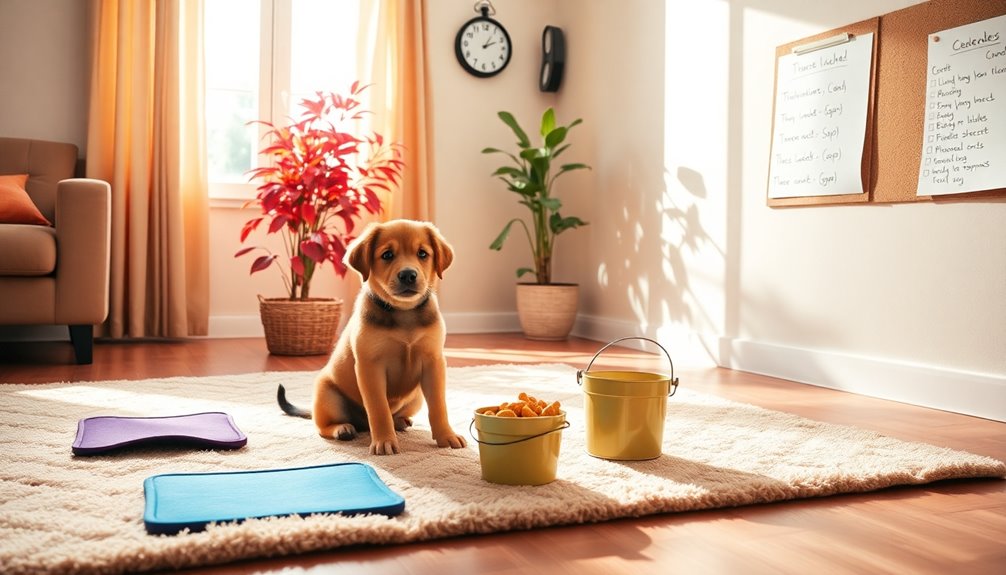To make crate time a positive space, start by placing the crate in a busy, familiar area and leaving the door open. Encourage your pet to explore with treats, praise, and toys, creating a sense of coziness and safety. Use routine to help your pet anticipate crate time, and avoid forcing them inside. Never use the crate as punishment. With patience and consistency, you’ll help your pet develop happy associations with their crate—learn more to make the experience even smoother.
Key Takeaways
- Leave the crate door open initially to encourage voluntary exploration and reduce anxiety.
- Use treats and toys to create positive associations with the crate.
- Place the crate in a common area to make it inviting and familiar.
- Reward your pet with praise and treats when they show curiosity or enter the crate.
- Keep crate training sessions short, positive, and consistent to build comfort and trust.

Have you ever wondered how crate training can simplify your pet’s daily routine? When done correctly, it becomes a valuable tool for both you and your furry friend. The key is to introduce the crate as a positive space, not a punishment. To do that effectively, you need to focus on crate training in a way that encourages your pet to see the crate as a safe, comfortable haven. It’s essential to prioritize crate safety by ensuring the crate is sturdy, well-ventilated, and appropriately sized. This means choosing a crate that allows your dog to stand, turn around, and lie down comfortably. Avoid crates that are too small or too large, as they can cause discomfort or confusion. Once you have the right crate, the goal is to make it inviting, so your pet willingly enters and feels secure inside.
Start by placing the crate in a common area of your home where you spend a lot of time. Leave the door open initially, and toss in some treats or favorite toys to encourage your pet to explore voluntarily. Don’t force your dog inside; instead, let curiosity take its course. When your pet shows interest, reward them with praise and treats. Over time, gradually increase the time they spend inside, always pairing the experience with positive reinforcement. This helps establish a strong association between the crate and good things happening, transforming it from a confinement space to a sanctuary your pet looks forward to.
Place the crate in a busy area, encourage exploration with treats, and reward your pet’s curiosity.
Consistency is crucial. Use the crate during specific times, like after meals or during your work hours, so your pet begins to anticipate and feel comfortable with the routine. Keep the environment inside the crate cozy by adding a soft blanket or familiar scent to make it even more inviting. Remember, crate safety is paramount—never leave your pet inside for extended periods without breaks, and always ensure they have access to water and ventilation. Avoid using the crate as a punishment; instead, keep training sessions short, positive, and gradual. Being aware of the importance of appropriate crate size can prevent discomfort and promote positive experiences.
Over time, your pet will associate the crate with comfort and safety. They’ll start to see it as their personal retreat, which makes daily routines easier for both of you. When your dog enters the crate willingly and feels secure, it reduces stress and prevents anxiety. Proper crate training, combined with a focus on crate safety, helps create a positive experience that benefits everyone. Your pet will develop trust in you, and you’ll gain peace of mind knowing they have a dedicated, cozy space they can enjoy at any time.
Frequently Asked Questions
How Long Should My Dog Stay in the Crate Daily?
You should limit your dog’s crate duration to about 3-4 hours during the day, especially if they’re still young. For daily confinement, aim for no more than 4-6 hours, including nap times, to prevent boredom and stress. Remember, dogs need regular breaks, exercise, and social interaction. Short, positive crate sessions help them see it as a safe space, making daily confinement both effective and humane.
What if My Dog Resists Going Into the Crate?
Did you know that about 70% of dogs adapt quickly to crate training? If your dog resists going into the crate, stay calm and patient. Use positive reinforcement, like treats and praise, to encourage your dog. Gradually introduce the crate as a safe space, and never force them in. Consistent, gentle training helps improve your dog’s behavior, making crate time a positive experience for both of you.
Can Crate Training Help With Separation Anxiety?
Yes, crate training can help with separation anxiety by providing your dog a safe, secure space. Using positive training techniques, you encourage your dog to associate the crate with comfort and calmness. Gradually increase crate time, rewarding calm behavior, and avoid punishment. Over time, your dog learns to feel relaxed alone, reducing anxiety and improving overall dog behavior when you’re apart.
What Type of Crate Is Best for Positive Reinforcement?
You should choose a crate with sturdy, comfortable material like plastic or metal to encourage positive feelings. The crate size should be just right—large enough for your dog to stand, turn around, and lie down comfortably, but not so big that they feel insecure. This helps create a safe, inviting space where your dog associates crate time with positive reinforcement, reducing anxiety and promoting trust.
How Do I Make the Crate More Inviting for My Pet?
You can make the crate more inviting by adding your dog’s favorite toy in a strategic spot, like near the back, to encourage exploration. Use crate scent enrichment by placing a blanket with familiar smells inside. Regularly rotate toys and scents to keep the space engaging. These steps help your pet associate the crate with comfort and positive experiences, making them more likely to enter and stay happily.
Conclusion
By making the crate a positive space, you can help your dog feel safe and secure. Remember, over 80% of dogs see their crate as a cozy refuge rather than a punishment. When you focus on creating a welcoming environment, your pup will look forward to crate time and develop a stronger bond with you. Keep patience and consistency in mind, and you’ll both enjoy the benefits of a happy, well-adjusted crate experience.










